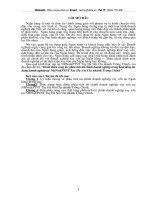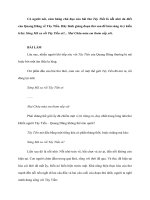Phân tích bài đọc trong toiec 11 docx
Bạn đang xem bản rút gọn của tài liệu. Xem và tải ngay bản đầy đủ của tài liệu tại đây (61.66 KB, 6 trang )
(b) fertilized their fields
(c) watered their crops
(d) planted their fields
3. The word "pits" in line 7 is closest in meaning to
(a) stages (b) scars
(c) seeds (d) holes
4. The word "stories" in line 12 is closest in meaning to
(a) articles (b) tales
(c) levels (d) rumors
5. Who would have been most likely to control the sacred objects
of an Anasazi family?
(a) A twenty-year-old man
(b) A twenty-year-old woman
(c) A forty-year-old man
(d) A forty-year-old woman
6. The word "they" in line 16 refers to
(a) women (b) crops
(c) rooms (d) pueblos
7. The word "disputes" in line 20 is closest in meaning to
(a) discussions
(b) arguments
(c) developments
(d) purchases
8. Which of the following activities was NOT done by Anasazi men?
(a) Making baskets
(b) Planting crops
(c) building homes
(d) Crafting jewelry
9. According to the passage, what made it almost impossible for other groups
to conquer the Anasazi?
(a) The political and social organization of th Anasazi
(b) The military tactics employed by the Anasazi
(c) The Anasazi's agricultural technology
(d) The natural barriers surrounding Anasazi villages
10. The passage supports which of the following generalizations?
(a) The presence of the Spanish threatened Anasazi society.
(b) The Anasazi benefited from trading relations with the Spanish.
(c) Anasazi society exhibited a well-defined division of labor.
(d) Conflicts between neighboring Anasazi villages were easily resolved.
Questions 11-20
Barbed wire, first patented in the United States in 1867, played an important
part in
the development of American farming, as it enabled the settlers to make
effective
fencing to enclose their land and keep cattle away from their crops. This had a
Line considerable effect on cattle ranching, since the herds no longer had unrestricted
use of
(5) the plains for grazing, and the fencing led to conflict between the farmers and
the cattle ranchers.
Before barbed wire came into general use, fencing was often made from
serrated
wire, which was unsatisfactory because it broke easily when under strain, and
could
snap in cold weather due to contraction. The first practical machine for
producing
(10) barbed wire was invented in 1874 by an Illinois farmer, and between then and
the end
of the century about 400 types of barbed wire were devised, of which only about
a
dozen were ever put to practical use.
Modern barbed wire is made from mild steel, high-tensile steel, or aluminum.
Mild
steel and aluminum barbed wire have two strands twisted together to form a
cable
(15) which is stronger than single-strand wire and less affected by temperature
changes. Single-strand wire, round or oval, is made from
high-tensile steel with the barbs
crimped or welded on. The steel wires used are galvanized ― coated with zinc
to make
them rustproof. The two wires that make up the line wire or cable are fed
separately into a machine at one end. They leave it at the other end
twisted together and barbed.
(20) The wire to make the barbs is fed into the machine from the sides and cut to
length by knives that cut diagonally through the wire to produce a
sharp point. This process continues automatically, and the finished
barbed wire is wound onto reels, usually
made of wire, in lengths of 400 meters or in weights of up to 50 kilograms.
A variation of barbed wire is also used for military purposes. It is formed into
long
coils or entanglements called concertina wire.
11. What is the main topic of the passage?
(a) Cattle ranching in the United States (b) A type of fencing
(c) Industrial uses of wire (d) A controversy over land use
12. The word "unrestricted" in line 4 is closest in meaning to
(a) unsatisfactory (b) difficult
(c) considerable (d) unlimited
13. The word "snap" in line 9 could best be replaced by which of the following?
(a) freeze (b) click
(c) loosen (d) break
14. What is the benefit of using two-stranded barbed wire?
(a) Improved rust-resistance (b) Increased strength
(c) More rapid attachment of barbs (d) Easier installation
15. According to the author, the steel wires used to make barbed wire are
specially processed to
(a) protect them against rust (b) make them more flexible
(c) prevent contraction in cold weather (d) strengthen them
16. The word "fed" in line 20 is closest in meaning to
(a) put (b) eaten
(c) bitten (d) nourished
17. The knives referred to in line 21 are used to
(a) separate double-stranded wire
(b) prevent the reel from advancing too rapidly
(c) twist the wire
(d) cut the wire that becomes barbs
18. What is the author's purpose in the third paragraph?
(a) To explain the importance of the wire
(b) To outline the difficulty of making the wire
(c) To describe how the wire is made
(d) To suggest several different uses of the wire
19. According to the passage, concertina wire is used for
(a) livestock management
(b) international communications
(c) prison enclosures
(d) military purposes
20. Which of the following most closely resembles the fencing described in the
passage?
Questions 21-29
Under certain circumstances, the human body must cope with gases at
greater-than-
normal atmospheric pressure. For example, gas pressures increase rapidly
during a dive
made with scuba gear because the breathing equipment allows divers to stay
Line underwater longer and dive deeper. The pressure exerted on the human body
increases
(5)
by 1 atmosphere for every 10 meters of depth in seawater, so that at 30 meters in
seawater a diver is exposed to a pressure of about 4 atmospheres. The pressure
of the
gases being breathed must equal the external pressure applied to the body ;
otherwise
breathing is very difficult. Therefore all of the gases in the air breathed by a
scuba
diver at 40 meters are present at five times their usual pressure. Nitrogen, which
(10) composes 80 percent of the air we breathe, usually causes a balmy feeling of
well-being at this pressure. At a depth of 5 atmospheres, nitrogen causes
symptoms
resembling alcohol intoxication, known as nitrogen narcosis. Nitrogen narcosis
apparently results from a direct effect on the brain of the large amounts of
nitrogen
dissolved in the blood. Deep dives are less dangerous if helium is substituted for
(15) nitrogen, because under these pressures helium does not exert a similar narcotic
effect.
As a scuba diver descends, the pressure of nitrogen in the lungs increases.
Nitrogen
then diffuses from the lungs to the blood, and from the blood to body tissues.
The
reverse occurs when the diver surfaces ; the nitrogen pressure in the lungs falls
and the
nitrogen diffuses from the tissues into the blood, and from the blood into the
lungs. If
(20) the return to the surface is too rapid, nitrogen in the tissues and blood cannot
diffuse
out rapidly enough and nitrogen bubbles are formed. They can cause severe
pains,
particularly around the joints.
Another complication may result if the breath is held during ascent. During
ascent
from a depth of 10 meters, the volume of air in the lungs will double because the
air
(25) pressure at the surface is only half of what it was at 10 meters. This change in
volume
may cause the lungs to distend and even rupture. This condition is called air
embolism.
To avoid this event, a diver must ascend slowly, never at a rate exceeding the
rise of
the exhaled air bubbles, and must exhale during ascent.
21. What does the passage mainly discuss?
(a) The equipment divers use
(b) The effects of pressure on gases in the human body
(c) How to prepare for a deep dive
(d) The symptoms of nitrogen bubbles in the bloodstream
22. The words "exposed to" in line 6 are closest in meaning to
(a) leaving behind (b) prepared for
(c) propelled by (d) subjected to
23. The word "exert" in line 15 is closest in meaning to
(a) cause (b) permit
(c) need (d) change
24. The word "diffuses" in line 19 is closest in meaning to
(a) yields (b) starts
(c) surfaces (d) travels
25. What happens to nitrogen in body tissues if a diver ascends too quickly?
(a) it forms bubbles.
(b) It goes directly to the brain
(c) It is reabsorbed by the lungs
(d) It has a narcotic effect
26. The word "they" in line 21 refers to
(a) joints (b) pains
(c) bubbles (d) tissues
27. The word "rupture" in line 26 is closest in meaning to
(a) hurt (b) shrink
(c) burst (d) stop
28. It can be inferred from the passage that which of the following
presents the greatest danger to a diver?
(a) pressurized helium
(b) Nitrogen diffusion
(c) Nitrogen bubbles
(d) An air embolism
29. What should a diver do when ascending?
(a) Rise slowly
(b) Breathe faster
(c) Relax completely
(d) Breathe helium








